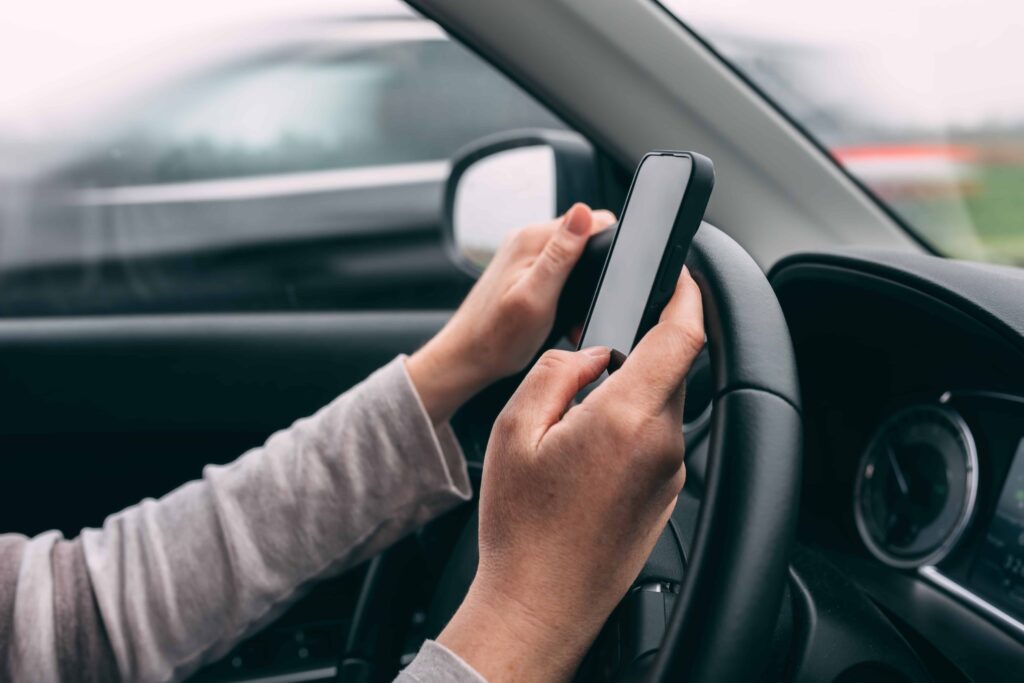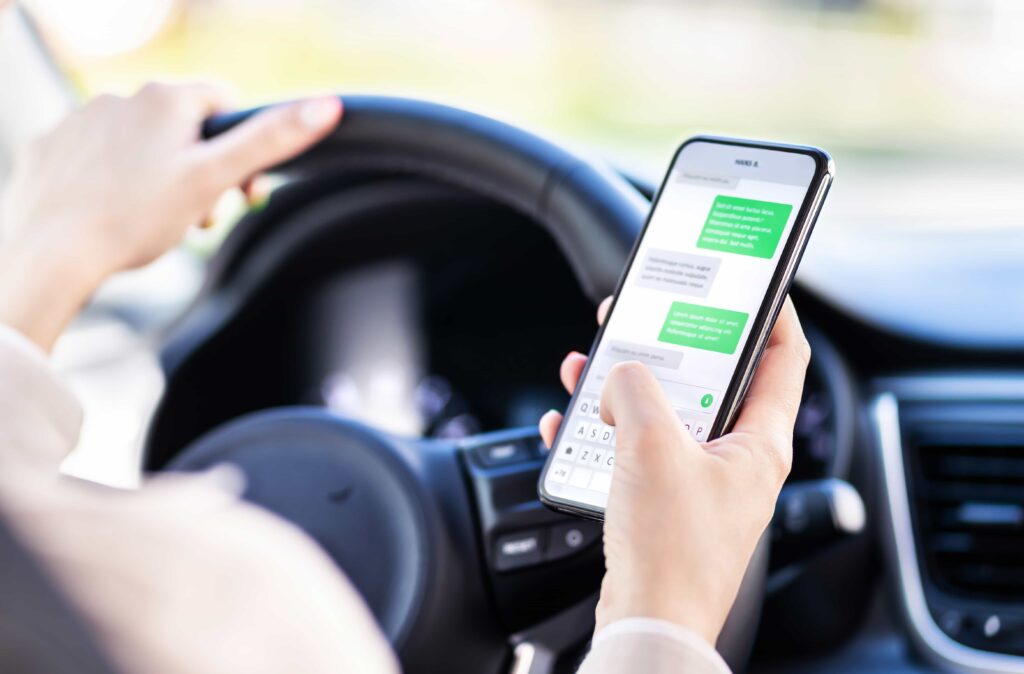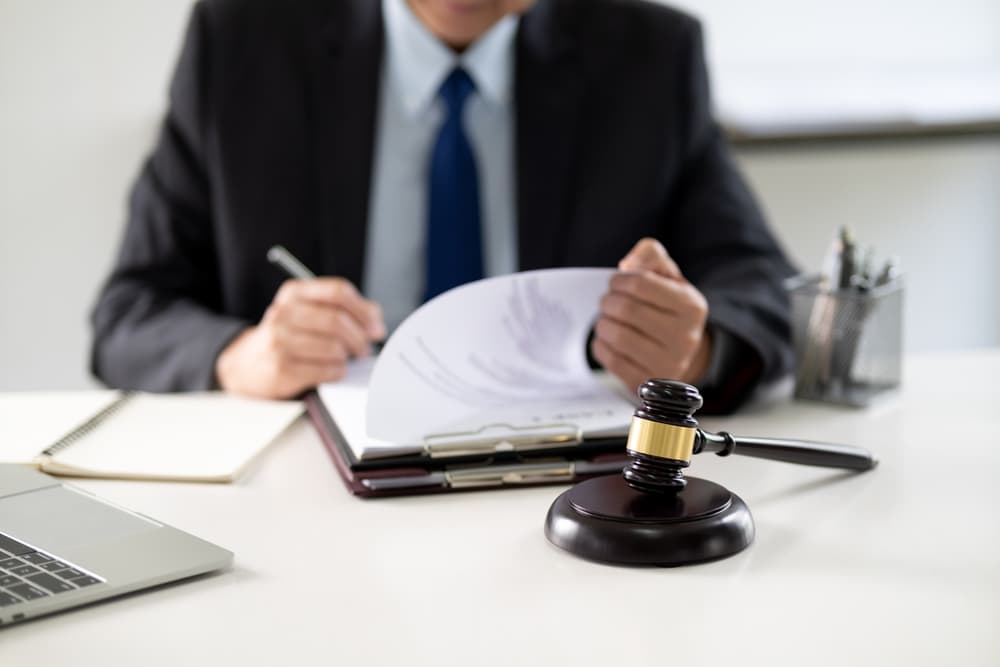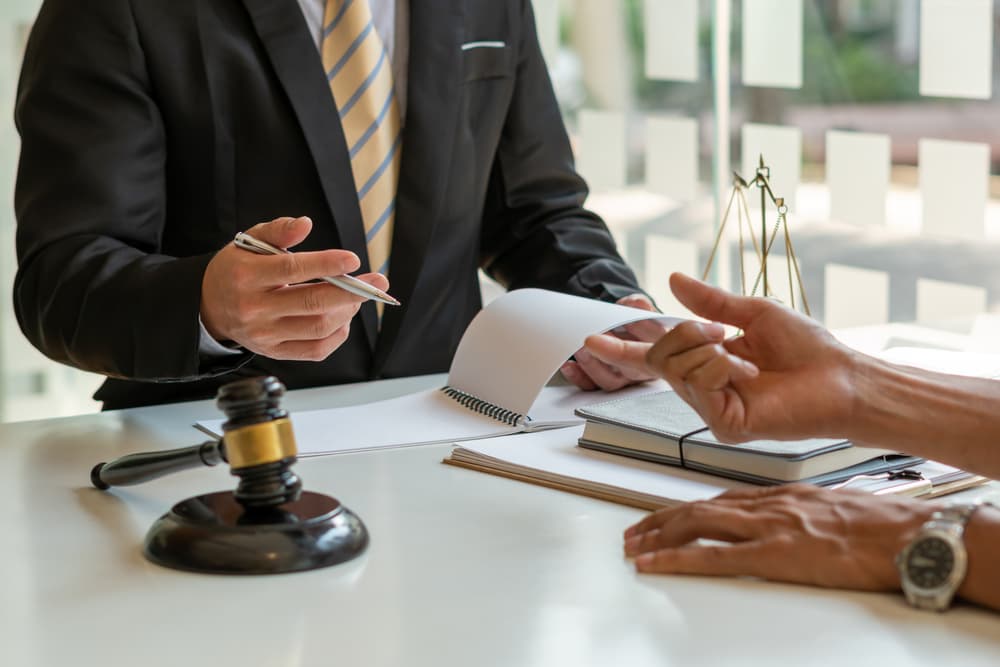Did You Get into an Accident with a Texting Driver? Here’s What You Can Do
Did You Get into an Accident with a Texting Driver? Here’s What You Can Do
The crash happened so quickly, you hardly had a chance to react. One moment, you drove attentively; the next, a distracted driver on their phone slammed into your car. Now you’re left with painful injuries, a damaged vehicle, and the stress of trying to piece your life back together, all because someone thought a text was worth more than your safety.
Texting while driving causes countless accidents, and too often, victims are the ones left to carry the burden. You don’t have to handle this alone. The car accident lawyers team at Bentley & More LLP can guide you through your options. Reach out today to learn how a dedicated personal injury attorney can help.
Accident with a Texting Driver: Key Takeaways
- Texting while driving creates clear evidence of negligence that strengthens injury claims against distracted drivers
- Cell phone records can prove drivers were actively texting at the time of accidents, providing compelling evidence for legal cases
- Texting driver accidents often result in higher compensation awards because juries view distracted driving as particularly reckless behavior
- Insurance companies may try to dispute whether texting actually caused accidents, making legal representation important for protecting your interests
- Multiple parties, including drivers, employers, and phone manufacturers, may bear liability in certain texting driver accident cases
- Call a car accident attorney to ensure proper investigation of cell phone evidence before it gets destroyed or becomes harder to obtain
Understanding Texting Driver Negligence
Texting while driving represents one of the clearest forms of driver negligence because it involves a conscious choice to engage in behavior that everyone knows creates serious accident risks. Unlike other forms of distracted driving that might be more subtle or arguable, texting requires drivers to take their eyes off the road. They must remove their hands from the steering wheel and focus their mental attention on something completely unrelated to safe driving.
The legal concept of negligence requires proving that drivers breached their duty of reasonable care, directly causing accidents that resulted in damages. Texting drivers clearly breach this duty because no reasonable person may consider it safe to read or send text messages while operating a vehicle in traffic. This makes texting driver cases relatively straightforward from a liability standpoint, though proving compensation amounts still requires careful documentation and legal advocacy.
Courts and juries often view texting while driving as particularly egregious behavior because drivers make conscious decisions to engage in activities they know are dangerous. Unlike accidents caused by momentary inattention or honest mistakes, texting involves deliberate choices to prioritize phone conversations over public safety. This perception frequently leads to higher damage awards and more favorable victim settlement negotiations.
Gathering Evidence of Phone Use

Proving that drivers were texting during accidents requires investigators to obtain cell phone records and match message activity with the crash timeline. These records, called “call detail records” or “CDRs,” provide timestamps for all phone activity, including voice calls, text messages, and data usage. Obtaining these records quickly is crucial because phone companies only maintain detailed records for limited periods.
Police reports sometimes include information about phone use if officers observe evidence at accident scenes or if drivers admit to texting. However, many texting drivers deny phone use or claim they weren’t actively engaged with their devices when crashes occurred. This makes independent investigation of phone records essential for building strong cases against distracted drivers.
Witness testimony can provide additional evidence of texting behavior if other drivers or passengers observed the distracted driver using their phone before the accident. Some witnesses report seeing drivers looking down at their phones, typing on devices, or appearing distracted in the moments leading up to crashes. Security footage from nearby businesses or traffic cameras may also capture evidence of distracted driving behavior.
Phone manufacturers and app developers maintain additional data that can prove device usage during accident times. Apps like social media platforms, messaging services, and navigation programs often log user activity with precise timestamps that can establish phone use patterns around crash times. This technical evidence requires legal subpoenas to obtain and analysis by computer forensics professionals to interpret properly.
Insurance Company Tactics in Texting Cases
Insurance companies defending texting driver claims employ various strategies to minimize payouts despite clear evidence of distracted driving. They may argue that phone use occurred before or after accidents rather than during the exact moments of impact. These technical arguments attempt to create reasonable doubt about whether texting directly caused crashes or just happened to occur around the same time.
Defense attorneys sometimes claim that other factors contributed to accidents even when drivers were texting, such as road conditions, weather, or actions by other drivers. They might argue that accidents may have occurred regardless of phone use, attempting to reduce their clients’ percentage of fault and corresponding liability for damages.
Some insurance companies dispute the extent of injuries claimed by texting driver accident victims, arguing that crash forces weren’t severe enough to cause serious trauma or that victims had pre-existing medical conditions that contributed to their symptoms. They may require multiple independent medical examinations or hire professionals who minimize injury severity in their reports.
Experienced car accident attorneys can counter these insurance company tactics by presenting compelling evidence of phone use, crash dynamics, and injury causation. They work with accident reconstruction professionals who can demonstrate how distracted driving led to specific crash scenarios and with medical professionals who can establish clear connections between accidents and resulting injuries.
Potential Liable Parties Beyond the Texting Driver

While texting drivers bear primary responsibility for accidents they cause, other parties may also face liability, depending on the circumstances surrounding crashes. Employers can be liable when employees cause accidents while texting for work-related purposes, even if company policies prohibit phone use while driving. This vicarious liability extends to employees responding to work emails, coordinating job activities, or conducting business calls.
Commercial trucking companies face particular scrutiny in texting driver cases because federal regulations prohibit commercial drivers from using phones while operating vehicles. Trucking companies that fail to enforce these regulations or encourage drivers to maintain constant communication may share liability when their drivers cause accidents while texting.
In some cases, phone manufacturers or app developers might bear partial liability if their products were designed to encourage use while driving or failed to implement safety features that can prevent texting in moving vehicles. These cases typically involve complex product liability theories and require extensive technical analysis of device design and functionality.
Property owners occasionally face premises liability claims when texting driver accidents occur due to poorly designed parking lots, inadequate lighting, or confusing traffic patterns that contribute to distracted driving crashes. These claims are less common but may apply when environmental factors combine with driver distraction to create particularly dangerous conditions.
Compensation After a Crash with a Texting Driver
Victims of texting driver accidents can recover compensation to address both the immediate and long-term consequences of their injuries. Economic damages include medical expenses for emergency treatment, surgery, rehabilitation, and ongoing care needs. These damages also cover lost income during recovery periods and reduced earning capacity when injuries prevent a return to previous employment levels.
Vehicle damage and other property losses represent additional economic damages that texting driver victims can recover through insurance claims or legal action. This includes repair or replacement costs, rental car expenses, personal property damaged in crashes, and diminished value of repaired vehicles.
Non-economic damages compensate for pain and suffering, emotional distress, and reduced quality of life resulting from texting-while-driving accidents. These damages recognize that serious injuries affect victims beyond financial losses, impacting their ability to enjoy recreational activities, maintain family relationships, and feel secure while driving.
Some texting driver cases may qualify for punitive damages when defendants’ behavior demonstrates reckless disregard for others’ safety. Punitive damages punish wrongdoers and discourage others from repeating the same behavior. Courts award them in distracted driving cases when drivers have prior histories of texting behind the wheel or when accidents cause severe injuries.
Building a Strong Case Against a Texting Driver

Successful texting driver accident cases require comprehensive evidence gathering beyond basic police reports and insurance investigations. This includes obtaining detailed phone records, analyzing crash dynamics, and documenting the full extent of injuries through medical records and professional testimony.
Medical documentation plays a crucial role in proving damages from texting driver accidents. This includes emergency room records, diagnostic imaging results, treatment plans, and ongoing care recommendations from healthcare providers. Victims should maintain detailed records of how injuries affect their daily activities, work performance, and overall quality of life.
Economic loss calculations require careful analysis of earnings statements, employment records, and career prospects to establish both current and future financial impacts of injuries. This analysis often involves economists or vocational rehabilitation professionals who can project lifetime earning losses and calculate present values of future damages.
Witness interviews and accident reconstruction may reveal additional evidence about crash causation and the distracted driver’s behavior leading up to the accident. Professional investigators can identify security cameras, interview bystanders, and examine physical evidence that strengthens cases against texting drivers.
Moving Forward After Your Accident with a Texting Driver
Recovery from texting driver accidents often involves both physical healing and legal resolution of compensation claims. Victims should prioritize following medical treatment recommendations while maintaining detailed records of symptoms, limitations, and progress throughout recovery.
Documentation becomes crucial for proving damages in legal proceedings. This includes medical records, income statements, photographs of injuries and vehicle damage, and personal journals describing how accidents affect daily life activities and emotional well-being.
Handle communication with insurance companies carefully, as adjusters often seek statements or documents they later use to minimize claim values. Having legal representation ensures that all communications protect victims’ interests while moving cases toward fair resolution
Steps to Protect Your Rights After a Texting Driver Accident

Texting while driving accidents can turn lives upside down, leaving you with painful injuries, mounting bills, and lost time from work. On top of that, the stress of repairing your car and dealing with insurance only adds to the burden. You do not have to go through this alone. Distracted drivers must be held accountable, but important evidence like phone records and witness details can disappear quickly. Acting fast can make a real difference in protecting your rights and strengthening your case.
At Bentley & More LLP, we help accident victims across Southern California pursue the justice and compensation they deserve after suffering an injury from texting drivers. Call (949) 870-3800 or contact us online to explore your legal options today.
FAQs After a Texting Driver Accident
How can lawyers prove the other driver was texting during my accident?
Attorneys obtain cell phone records called “call detail records” that show exact times of calls, texts, and data usage. You can compare these records to accident times to prove phone use.
What if the texting driver claims they weren’t actively using their phone when the crash happened?
Phone records reveal all device activity—including when messages were opened, typed, or sent—and provide objective evidence that contradicts driver denials about phone use.
Can I still recover compensation if I also did something that contributed to the accident?
Yes, even if you bear some responsibility, you can still recover compensation reduced by your percentage of fault, though texting drivers typically bear primary liability.
How long do I have to file a lawsuit against a texting driver?
Most states give you two years from the accident date to file lawsuits, but you must preserve evidence quickly because phone records and other proof can disappear fast. Acting promptly also strengthens your case by maintaining the accuracy and availability of key evidence.
What if the texting driver’s insurance isn’t enough to cover my damages?
Additional compensation sources may include your own underinsured motorist coverage, employer liability if the driver was working, or umbrella policies that provide extra coverage beyond basic limits. Exploring all potential sources ensures you maximize the recovery available for your injuries and losses.


